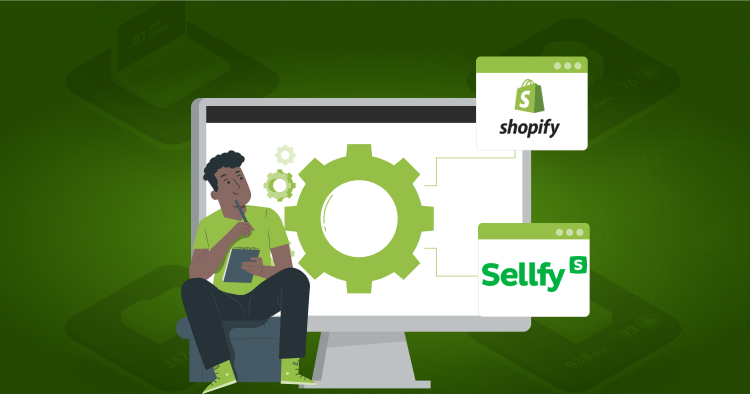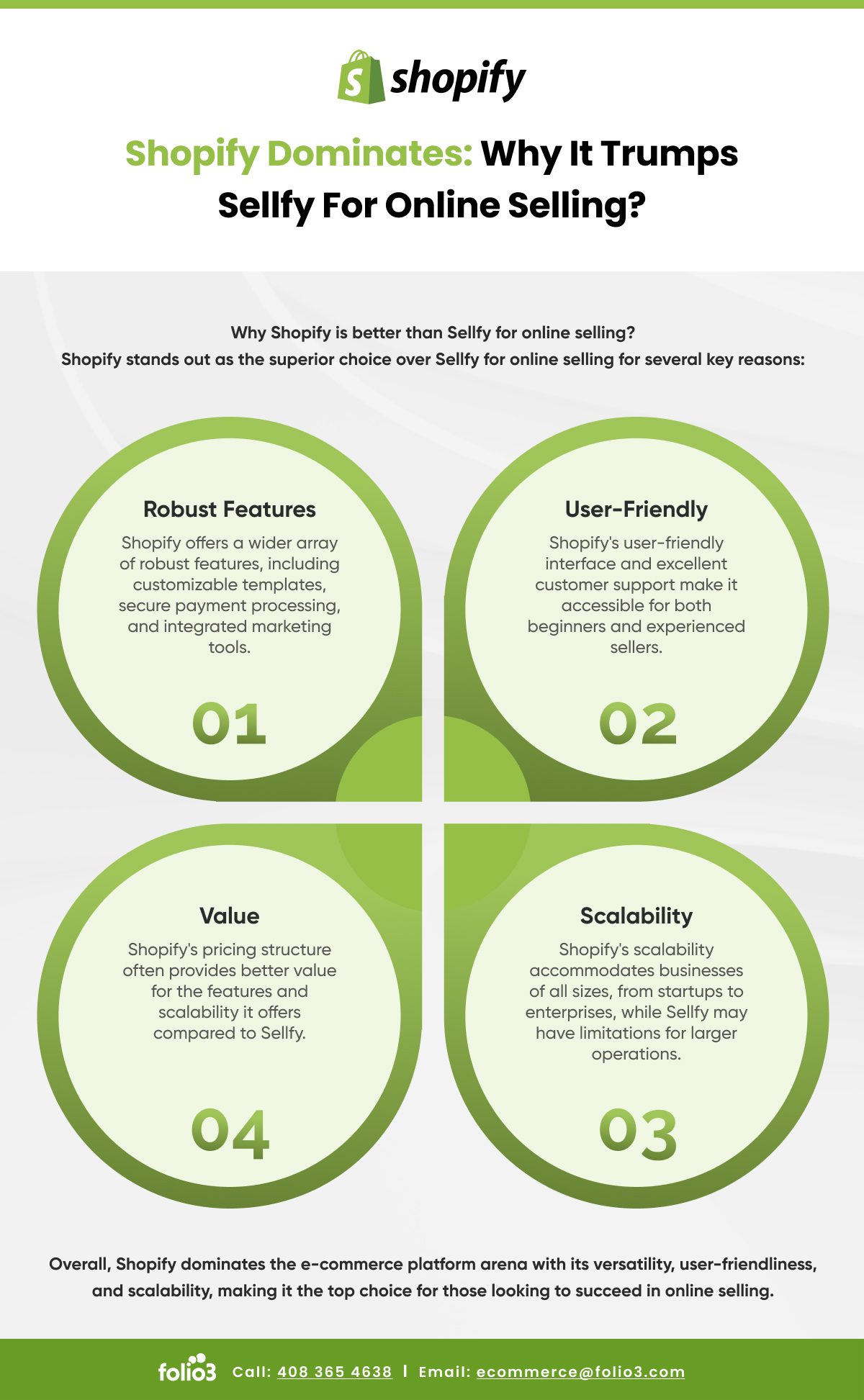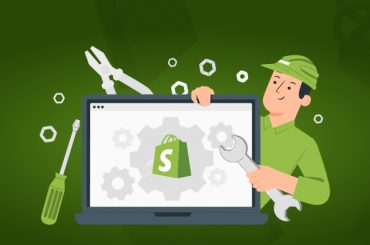Sellfy vs Shopify: A Comprehensive Comparison of Key E-commerce Features
Last Updated | January 8, 2024
Table of Contents
In the ever-evolving landscape of e-commerce development solutions, businesses are presented with a diverse array of options to establish their digital presence and drive online sales. Among these options, Sellfy and Shopify emerge as prominent contenders, each offering a comprehensive suite of tools to facilitate seamless web development and online selling.
If you, too, are looking to start your own eCommerce store and confused comparing sellfy vs shopify as the right web development platform, then continue reading. Below, we will diver into the key attributes of both platforms, shedding light on their capabilities and assisting entrepreneurs in making an informed choice for their e-commerce journey.
So, without any ado, let’s get started…
Sellfy Vs. Shopify – A Brief Introduction
Well, before we diver into technical complexities of each platform, let’s quickly get brief introduction both platforms and see key features that they bring to the table.
Sellfy: An Overview
Sellfy, a robust e-commerce platform, caters to creators, digital artists, and entrepreneurs seeking to sell their products online. With its user-friendly interface and streamlined setup process, Sellfy enables individuals to establish their online stores quickly. The platform’s design flexibility and customization options empower users to create visually appealing storefronts that resonate with their brand identity. Additionally, Sellfy’s marketing tools and features facilitate direct engagement with customers, enabling creators to focus on their craft while the platform handles the sales infrastructure.
Key Features of Sellfy:
- Digital product selling capabilities tailored for creators
- User-friendly interface and quick setup process
- Customizable design templates for brand consistency
- Built-in marketing tools for direct customer engagement
- Integration possibilities for third-party applications
Shopify: A Glimpse
Shopify stands as a heavyweight in the e-commerce arena, serving a wide spectrum of businesses, from startups to enterprises. The platform’s user experience is marked by its intuitive interface, allowing users to set up and manage their online stores without the need for extensive technical knowledge. The design prowess of Shopify shines through its diverse selection of professionally crafted highly converted themes, ensuring an engaging and user-friendly shopping experience. Moreover, Shopify’s app ecosystem extends its functionality, enabling businesses to tailor their online presence to their specific needs.
Key Features of Shopify:
- Versatile platform catering to businesses of varying scales
- Intuitive user interface for straightforward store setup
- Extensive collection of themes for a visually appealing storefront
- App Store offering a wide range of integrations and enhancements
- In-built marketing tools and features for customer engagement
Read Also Cart.com vs Shopify
Sellfy Vs Shopify – The Battle Begins!
Well, now that we are done with the introduction of the two platforms, let’s move on to our main agenda and delve deeper into comparing various features and functionalities of the two platforms:
Sellfy Vs Shopify Functionality
Sellfy
When considering the functionality of an e-commerce platform, Sellfy positions itself as a versatile and user-oriented solution. Entrepreneurs seeking to sell digital products or creative endeavors can find Sellfy to be a tailored fit.
Its intuitive dashboard and user-friendly interface pave the way for a seamless experience, even for those with limited technical background. Sellfy’s functionality encompasses a range of features, from digital product selling capabilities to built-in marketing tools, making it an all-in-one solution for creators.
Key Functionality Highlights of Sellfy:
- Digital Product Focus: Sellfy thrives in catering to digital content creators. From e-books and digital art to music and videos, Sellfy is engineered to handle the intricacies of selling intangible goods.
- Streamlined Management: Sellfy’s backend allows easy management of products, including organization, pricing, and customization options.
- Direct Selling Channels: With inbuilt marketing tools like email campaigns and discounts, Sellfy empowers creators to engage with their audience and generate sales directly.
Shopify
Turning our attention to Shopify’s functionality, we encounter a robust and flexible platform designed to accommodate businesses of diverse sizes and industries. Shopify’s functionality extends across various dimensions, enabling entrepreneurs to create and manage their online stores with ease.
Its user interface is user-centric, facilitating efficient store setup and navigation. The sheer range of features embedded within Shopify encompasses the entire e-commerce spectrum, from product management to customer engagement.
Key Functionality Highlights of Shopify:
- Scalability and Versatility: Shopify’s functionality is geared towards businesses at different stages of growth, making it an adaptable choice for startups and established enterprises alike.
- Intuitive Interface: With a user-friendly dashboard, even individuals without coding skills can swiftly set up and customize their online stores.
- Comprehensive Feature Set: Shopify offers an extensive toolbox, including inventory management, order tracking, and integrations with various payment gateways.
- Marketing Suite: Inbuilt marketing tools, SEO-friendly features, and email campaigns amplify Shopify’s functionality for enhancing customer reach.
Read Also Launch Cart vs Shopify
Sellfy Vs Shopify Design and Themes
Sellfy
When it comes to design and themes, Sellfy caters to those who seek an elegant and user-centric online storefront. The platform offers a variety of customizable design templates that allow entrepreneurs to align their digital presence with their brand identity effortlessly. Sellfy’s design options emphasize aesthetics and user experience, ensuring that visitors are engaged and find navigating the store intuitive. Whether you’re selling digital art, music, or e-books, Sellfy’s themes are tailored to elevate your products and connect with your audience.
Key Design and Theme Highlights of Sellfy:
- Customization Ease: Sellfy’s themes are designed with simplicity in mind, allowing for easy theme customization without hiring a Shopify technical expert.
- Engaging Visuals: The design templates are optimized for showcasing digital products, ensuring that each item is presented in its best light.
- Responsive Interface: Sellfy’s themes are responsive, ensuring a seamless shopping experience across devices.
- Consistent Branding: Tailor your storefront to your brand’s visual elements for a cohesive and professional appearance.
Shopify
On the other hand, Shopify’s approach to design and themes is equally robust and versatile. Whether you’re a startup or an established enterprise, Shopify offers an extensive range of professionally crafted themes. These themes cater to a wide spectrum of industries and product types, allowing you to select a design that resonates with your business. The themes are engineered with responsiveness in mind, ensuring that your online store appears polished and navigable regardless of the device your customers are using.
Read Also Shopify vs Snipcart
Key Design and Theme Highlights of Shopify:
- Diverse Theme Collection: Shopify boasts a library of theme development that can be tailored to meet your business’s unique aesthetic and purpose.
- User-Friendly Customization: Customizing your chosen theme is a seamless process, enabling you to modify design elements without coding.
- Mobile Optimization: Shopify’s themes are optimized for mobile devices, providing a consistent user experience on smartphones and tablets.
- Visual Appeal: The themes are crafted to captivate visitors and encourage them to explore your products further.
Sellfy Vs Shopify Development Time
Sellfy
Embarking on your e-commerce journey, the element of time holds paramount importance. Sellfy, catering particularly to creators and entrepreneurs of digital products, streamlines the development process. Its user-friendly interface and intuitive setup facilitate the creation of an online store without the complexities that often accompany web development. The emphasis on simplicity allows you to focus on refining your products and engaging with your audience, as opposed to grappling with intricate technicalities.
Key Development Time Considerations for Sellfy:
- Efficiency: Sellfy’s straightforward setup expedites the launch of your digital store, enabling you to start selling sooner.
- Intuitive Onboarding: The platform’s step-by-step guidance simplifies the process for creators, reducing the learning curve.
- Quick Turnaround: Sellfy’s design and features are curated for swift development, allowing you to dedicate more time to your creative pursuits.
Read Also Shopify Plus vs Shopify Advanced
Shopify
Shifting our focus to Shopify plus development time, we encounter a platform equally committed to efficiency and user-friendliness. With its versatility catering to businesses of various sizes and industries, Shopify has engineered an intuitive process that guides you through every step of creating an online store. The platform’s user interface empowers individuals with limited technical expertise, facilitating a hassle-free setup. Shopify’s goal is to provide a balance between flexibility and rapidity, ensuring that launching an online store does not become an arduous endeavor.
Key Development Time Considerations for Shopify:
- User-Centric Interface: Shopify’s interface is designed for user-friendly navigation, simplifying store setup and management.
- Time Optimization: The platform’s intuitive tools enable efficient store creation, allowing you to invest time in other essential aspects of your business.
- Scalability: Shopify’s versatility extends to development, making it suitable for both new ventures and established enterprises.
Sellfy vs. Shopify Features
Sellfy
When evaluating the features offered by Sellfy, we find a tailored suite designed to meet the specific needs of creators and digital entrepreneurs. Sellfy shines in its ability to empower individuals who are focused on selling digital products, be it ebooks, artwork, music, or more. The platform’s functionality revolves around file protection, bundling, and versatile product presentation. It caters to creators by ensuring the security of their digital content, streamlining product bundling, and enhancing the visual appeal of their offerings.
Read Also Shopify Vs Gumroad
Key Feature Highlights of Sellfy:
- File Protection: Sellfy prioritizes safeguarding digital products, allowing creators to share their work without fear of unauthorized access.
- Bundling Advantage: Creators can bundle products together, providing customers with an enticing package deal.
- Versatile Product Presentation: Sellfy enables varied product presentations, including previews and customized storefronts.
Shopify
Shifting our focus to Shopify’s features, we encounter a comprehensive toolbox that caters to a diverse range of businesses. From startups to enterprises, Shopify’s functionalities are designed to support growth and scalability. One of its standout features is the abandoned cart recovery tool, which aids in re-engaging potential customers who left items in their carts. Additionally, Shopify’s gift card functionality adds a layer of flexibility to businesses looking to enhance customer engagement and loyalty.
Key Feature Highlights of Shopify:
- Abandoned Cart Recovery: Shopify’s feature helps re-engage potential buyers who left items in their carts, contributing to increased conversions.
- Gift Cards: The gift card feature allows businesses to offer customizable gift cards, promoting customer loyalty and boosting sales.
- Extensive App Ecosystem: Shopify’s App development Store offers a wide array of integrations to extend functionality and tailor the platform to unique business needs.
Read Also Shopify vs Custom Website
Sellfy Vs Shopify Payment Gateways and Fees
Sellfy
Navigating the world of e-commerce, the consideration of payment gateways and associated fees is a key aspect Sellfy caters to this aspect by offering a range of payment gateway options, ensuring that creators and entrepreneurs have the flexibility to transact in ways that align with their preferences. The platform supports widely used gateways, allowing customers to complete transactions through methods they are comfortable with. Additionally, Sellfy maintains transparency in its fee structure, ensuring that sellers are aware of the costs involved.
Key Payment Gateway and Fee Considerations for Sellfy:
- Payment Options Diversity: Sellfy supports multiple payment gateways, allowing customers to pay using methods they are accustomed to.
- Transparent Fees: The platform ensures that sellers are well-informed about the fees associated with transactions, enhancing financial clarity.
- Creator Convenience: Sellfy’s payment setup empowers creators to focus on their products, without getting entangled in complex payment processes.
Shopify
Shifting our focus to Shopify’s payment gateways and fees, we encounter a platform that prioritizes customer convenience and global reach. Shopify’s extensive range of payment gateways transcends geographical boundaries, allowing businesses to cater to customers worldwide. The platform is dedicated to fostering customer trust, integrating with reputable gateways to ensure secure Shopify transactions. While Shopify does impose transaction fees, they can be mitigated through the use of the platform’s native payment gateway, Shopify Payments.
Key Payment Gateway and Fee Considerations for Shopify:
- Global Reach: Shopify’s diverse payment gateways enable businesses to serve customers across different countries and regions.
- Trust and Security: The platform integrates with trusted payment gateways, prioritizing secure and reliable transactions.
- Transaction Fee Flexibility: While Shopify does have transaction fees, businesses can reduce them by utilizing Shopify Payments, the platform’s native gateway.
Read Also Shopify’s SaaS platform vs. Other Open Source
Sellfy Vs Shopify Budget and Pricing
Sellfy
In the world of e-commerce, budget considerations play a key role in success of failure of your online business. Sellfy steps in with a pricing structure tailored for creators and digital entrepreneurs. The platform offers a range of plans to suit varying needs, making it accessible to both individuals embarking on their creative journey and established artists looking to enhance their online presence. Sellfy’s pricing model aligns with the scale of digital offerings, ensuring that you pay for the features you require without unnecessary frills.
Key Budget and Pricing Considerations for Sellfy:
- Flexible Pricing Tiers: Sellfy’s tiered plans cater to creators at different stages, allowing them to select a plan that aligns with their requirements.
- Value for Features: The platform ensures that each pricing tier offers value proportionate to the features included, optimizing your investment.
- Scalability: As your digital products gain traction, Sellfy’s scalability allows you to seamlessly transition to higher tiers for expanded features.
Shopify
Turning our attention to Shopify’s budget and pricing model, we encounter a platform designed to accommodate businesses across the spectrum, from startups to enterprises. Shopify offers a tiered pricing structure, each designed to address the diverse needs of businesses. This approach empowers you to select a plan that corresponds with your business size and goals. Shopify’s transparent pricing structure ensures that you understand the investment required for the features you seek, creating a straightforward decision-making process.
Sellvia vs Shopify: Unraveling the Differences to Boost Your E-commerce Success!
Key Budget and Pricing Considerations for Shopify:
- Tiers for All: Shopify’s tiered pricing accommodates businesses of all sizes, making it accessible for startups and established enterprises.
- Value Alignment: Each pricing tier is crafted to offer commensurate value, providing a range of features that elevate your e-commerce venture.
- Scaling Opportunities: As your business evolves, Shopify’s scalability allows you to seamlessly upgrade to higher tiers for more advanced capabilities.
Sellfy Vs Shopify Marketing Tools
Sellfy
In the dynamic landscape of e-commerce, marketing tools wield substantial influence in elevating your digital business. Sellfy, attuned to the needs of creators and digital entrepreneurs, equips you with a range of marketing functionalities. The platform’s email marketing integration allows you to engage with your audience effectively. Coupled with customizable discount codes, you can incentivize purchases and foster customer loyalty. Additionally, Sellfy’s social media integration enables seamless product sharing, extending your reach to a wider audience.
Key Marketing Tool Highlights for Sellfy:
- Email Marketing Integration: Sellfy’s integration with email marketing platforms empowers you to communicate with your audience and drive conversions.
- Discount Codes: Customizable discount codes enable you to entice customers and prompt sales, enhancing customer engagement.
- Social Media Reach: Social media integration facilitates effortless sharing of your products, broadening your online presence.
Shopify
Transitioning to Shopify’s marketing tools, we encounter a powerhouse that caters to businesses across various scales. The platform’s array of marketing features encompasses diverse strategies to amplify your brand’s visibility. One such feature is abandoned cart recovery, which assists in recovering potential lost sales. Additionally, Shopify’s integration with social media platforms enables direct selling through social channels, streamlining the shopping experience for customers.
Key Marketing Tool Highlights for Shopify:
- Abandoned Cart Recovery: Shopify’s abandoned cart recovery tool aids in re-engaging potential customers who left items in their carts, boosting conversions.
- Direct Social Selling: The platform’s social media integration empowers businesses to sell directly through social channels, enhancing customer convenience.
- Email Campaigns: Shopify’s email marketing tools allow businesses to design and execute email campaigns to nurture customer relationships.
Sellfy Vs Shopify SEO
Sellfy
In the ever-evolving landscape of e-commerce, the significance of Search Engine Optimization (SEO) cannot be overstated. Sellfy acknowledges this importance and equips creators and digital entrepreneurs with tools to enhance their online visibility. The platform optimizes product pages for search engines, ensuring that your offerings stand a better chance of being discovered by potential customers. By providing fields for titles, descriptions, and keywords, Sellfy empowers you to craft content that aligns with the search intent of your target audience.
Key SEO Considerations for Sellfy:
- Optimized Product Pages: Sellfy ensures that your product pages are optimized for search engines, boosting discoverability.
- Metadata Customization: The platform provides fields for titles, descriptions, and keywords, enabling you to tailor content for higher search rankings.
- Enhanced Visibility: By implementing SEO best practices, Sellfy helps you attract organic traffic and increase the visibility of your offerings.
Shopify
Turning our attention to Shopify’s SEO capabilities, we encounter a platform that is keen on providing businesses with the tools necessary for an effective online presence. The platform offers customizable title tags, meta descriptions, and URLs for products and pages. Moreover, Shopify generates sitemaps automatically, aiding search engines in understanding the structure of your online store. The platform’s focus on responsive website design also contributes to favorable search rankings, ensuring your store is accessible across devices.
Key SEO Considerations for Shopify:
- Customizable Metadata: Shopify allows businesses to customize title tags, meta descriptions, and URLs for better search engine visibility.
- Automated Sitemaps: The platform generates sitemaps automatically, aiding search engines in understanding your online store’s structure.
- Responsive Design: Shopify’s emphasis on responsive design enhances user experience across devices, contributing to higher search rankings.
Sellfy vs. Shopify Dropshipping
Sellfy
As the e-commerce landscape evolves, the concept of dropshipping has garnered considerable attention, offering a streamlined business model for entrepreneurs. Sellfy acknowledges the significance of this approach and equips creators with tools to facilitate dropshipping ventures. The platform enables you to integrate third-party fulfillment services seamlessly, allowing you to focus on crafting and marketing your digital products. This approach simplifies the process of delivering products to customers without the need for physical inventory management.
Key Dropshipping Considerations for Sellfy:
- Third-Party Fulfillment Integration: Sellfy facilitates seamless integration with third-party fulfillment services, easing the dropshipping process.
- Focus on Creativity: By streamlining fulfillment, Sellfy empowers creators to focus on their creative endeavors and product marketing.
- Inventory Management Simplification: With dropshipping, the complexities of inventory management are reduced, enhancing operational efficiency.
Shopify
Transitioning to Shopify’s dropshipping capabilities, we encounter a platform that has embraced this business model extensively. Shopify integrates with a multitude of dropshipping apps and platforms, providing businesses with the flexibility to establish dropshipping relationships. This allows entrepreneurs to offer a wider range of products without the burden of stocking physical inventory. Moreover, Shopify’s order fulfillment features streamline the process, ensuring a seamless experience for both businesses and customers.
Read Also Shopify Dropshipping in UAE
Key Dropshipping Considerations for Shopify:
- Dropshipping App Integration: Shopify’s compatibility with numerous dropshipping apps extends flexibility for businesses seeking to adopt this model.
- Product Diversity: Dropshipping enables entrepreneurs to offer a diverse array of products without investing in physical inventory.
- Order Fulfillment Streamlining: Shopify’s order fulfillment features contribute to a hassle-free process, from order placement to delivery.
Sellfy Vs Shopify Customer Help and Technical Support
Sellfy
In the dynamic world of e-commerce, reliable customer help and technical support are invaluable lifelines for businesses. Sellfy, attuned to the needs of creators and digital entrepreneurs, offers a customer support system that strives to enhance your experience. The platform provides a knowledge base replete with resources, enabling you to troubleshoot common issues independently. Furthermore, Sellfy extends email support to assist you with specific queries, ensuring that your concerns are addressed promptly.
Key Customer Support Considerations for Sellfy:
- Resourceful Knowledge Base: Sellfy’s comprehensive knowledge base empowers you to address common challenges on your own.
- Email Support: The platform offers email support to address specific queries and provide personalized assistance.
- Self-Help Emphasis: By offering resources and guidance, Sellfy emphasizes empowering users to resolve issues independently.
Shopify
Shifting our focus to Shopify’s customer help and technical support, we encounter a platform that has invested significantly in this critical aspect. Shopify provides 24/7 customer support through various channels, ensuring assistance is available when you need it most. The platform offers live chat, email, and phone support, enabling you to seek guidance in real time. Moreover, Shopify’s vast community forum and extensive documentation serve as valuable resources for troubleshooting and gaining insights.
Key Customer Support Considerations for Shopify:
- 24/7 Support: Shopify’s round-the-clock customer support ensures that assistance is accessible at any time.
- Multichannel Assistance: Live chat, email, and phone support options provide flexibility for seeking real-time guidance.
- Community Engagement: Shopify’s community forum fosters interaction, enabling users to learn from one another’s experiences.
Sellfy Vs Shopify Integration
Sellfy
In the world of e-commerce, seamless integration capabilities can greatly impact the efficiency and scalability of your business operations. Sellfy recognizes the importance of integrations and offers a selection of key integrations tailored to creators and digital entrepreneurs. By connecting with email marketing platforms, you can nurture customer relationships effectively. Social media integration facilitates effortless sharing of your products, enhancing your online presence. Additionally, Sellfy’s integration with analytics tools empowers you to gain insights into your store’s performance.
Key Integration Considerations for Sellfy:
- Email Marketing Integration: Sellfy seamlessly integrates with email marketing platforms, enabling targeted customer communication.
- Social Media Connectivity: Social media integration aids in the amplification of your product reach through various channels.
- Analytics Insights: Sellfy’s integration with analytics tools assists you in understanding your store’s performance and customer behavior.
Shopify
Turning our attention to Shopify’s integration capabilities, we uncover a platform that boasts an extensive ecosystem of third-party apps and integrations. This ecosystem covers a wide spectrum of functionalities, ranging from accounting and inventory management to customer service and marketing. Whether you’re seeking to streamline your operations or enhance your customer engagement, Shopify’s integrations offer a solution. With options to integrate seamlessly with various tools, you can tailor your e-commerce setup to meet your specific requirements.
Key Integration Considerations for Shopify:
- Ecosystem of Apps: Shopify’s extensive ecosystem encompasses a wide array of third-party apps and integrations.
- Functional Diversity: Integrations cover areas such as accounting, inventory management, marketing, and more.
- Customizable Setup: Shopify allows you to tailor your e-commerce setup by choosing the integrations that align with your business needs.
Sellfy Vs Shopify Sales Features
Sellfy
In the dynamic world of e-commerce, the effectiveness of your sales strategy hinges on the robustness of your platform’s sales features. Sellfy caters to creators and digital entrepreneurs by offering a range of sales-focused tools. The platform enables you to create customizable discounts and promotional campaigns, enticing your audience with compelling offers. Additionally, Sellfy facilitates the sale of digital products like ebooks, music, videos, and more, providing a platform where your creative endeavors can flourish.
Key Sales Features for Sellfy:
- Customizable Discounts: Sellfy equips you with the ability to create tailored discounts, enabling strategic promotional efforts.
- Promotional Campaigns: The platform empowers you to craft enticing promotional campaigns to attract and engage customers.
- Diverse Product Offerings: Sellfy’s support for digital products like ebooks, music, and videos opens avenues for creative sales.
Shopify
Transitioning to Shopify’s sales features, we encounter a platform renowned for its versatile sales tools. Shopify enables businesses to design and manage their online stores with ease. The platform offers a range of customizable templates and themes, facilitating the creation of visually appealing storefronts. Shopify’s integration with various payment gateways ensures that customers can make purchases conveniently. Furthermore, the platform’s sales analytics provide insights into your store’s performance, aiding in informed decision-making.
Key Sales Features for Shopify:
- Visually Appealing Storefronts: Shopify’s customizable templates and themes empower businesses to create visually engaging online stores.
- Payment Gateway Integration: The platform seamlessly integrates with diverse payment gateways, ensuring convenient customer transactions.
- Sales Analytics: Shopify’s sales analytics feature provides valuable insights into your store’s speed optimization and customer behavior.
Sellfy Vs Shopify Inventory Management
Sellfy
Efficient inventory management is the cornerstone of a successful business. Sellfy, equips creators and digital entrepreneurs with tools to manage their inventory with precision. The platform enables you to monitor product availability in real-time, ensuring that you never oversell or disappoint customers. Additionally, Sellfy’s inventory tracking features allow you to stay on top of stock levels, triggering timely restocking to prevent stockouts.
Key Inventory Management Considerations for Sellfy:
- Real-time Availability Monitoring: Sellfy empowers you to keep track of product availability in real-time, preventing overselling.
- Inventory Tracking: The platform’s inventory tracking features enable you to manage stock levels efficiently and restock when necessary.
- Stockout Prevention: Sellfy’s tools aid in preventing stockouts by facilitating timely restocking decisions.
Shopify
Shifting our attention to Shopify’s inventory management capabilities, we encounter a platform renowned for its meticulous approach. Shopify provides an array of features to assist businesses in maintaining a well-organized Shopify sync inventory. The platform enables you to track stock levels, receive notifications for low inventory, and automate restocking processes. Furthermore, Shopify’s integration with various order management systems ensures that your inventory operations align seamlessly with your sales.
Key Inventory Management Considerations for Shopify:
- Stock Tracking: Shopify’s stock tracking tools enable businesses to maintain accurate inventory records.
- Low Inventory Notifications: The platform notifies you when stock levels are low, preventing unexpected stockouts.
- Automated Restocking: Shopify automates restocking processes, streamlining inventory management.
- Order Management Integration: Integration with order management systems ensures synchronized inventory and sales operations.
Sellfy Vs Shopify Mobile Responsiveness
Sellfy
In the digital era, where smartphones and tablets have become integral parts of our lives, the importance of mobile responsiveness cannot be overstated. Sellfy, catering to the needs of creators and digital entrepreneurs, ensures that your online store provides a seamless experience across various devices. The platform’s responsive design adapts your store’s layout and content to fit different screen sizes, guaranteeing that your customers can browse, interact, and make purchases effortlessly, whether they’re on a smartphone, tablet, or desktop.
Key Mobile Responsiveness Considerations for Sellfy:
- Responsive Design: Sellfy’s responsive design ensures that your online store adjusts to different screen sizes.
- Effortless Browsing: Customers can seamlessly browse, interact, and shop using smartphones, tablets, or desktops.
- Consistent Experience: Mobile responsiveness guarantees a consistent and user-friendly experience across devices.
Shopify
Turning our focus to Shopify’s mobile responsiveness, we encounter a platform renowned for its commitment to providing an optimal user experience. Shopify empowers businesses to create mobile-friendly online stores that cater to the preferences of modern consumers. With responsive themes and templates, your store’s design remains engaging and functional, regardless of the device being used. This means that your customers can explore your products, navigate categories, and complete transactions with ease, enhancing their overall satisfaction.
Key Mobile Responsiveness Considerations for Shopify:
- Responsive Themes: Shopify offers responsive themes that ensure your store looks and functions well on various devices.
- Engaging Design: The platform’s mobile-friendly design keeps customers engaged while providing intuitive navigation.
- Smooth Transactions: Mobile-responsive stores enable seamless browsing and transactions for improved customer satisfaction.
Sellfy Versus Shopify Application Integrations
Sellfy
In the dynamic landscape of e-commerce, the ability to seamlessly integrate with external applications can greatly enhance the functionality and reach of your online store. Sellfy acknowledges this need and offers a range of application integrations to amplify your e-commerce journey. The platform enables creators and digital entrepreneurs to connect with third-party tools that cater to various aspects of their business, such as marketing, analytics, customer relationship management, and more. By integrating these applications, Sellfy users can streamline their operations, gain valuable insights, and elevate their online presence.
Key Application Integration Considerations for Sellfy:
- Diverse Integration Options: Sellfy offers integration with a variety of third-party tools for different business needs.
- Streamlined Operations: Application integrations allow users to automate tasks and streamline their business operations.
- Data-Driven Insights: Integrated analytics and tools provide valuable insights for informed decision-making.
- Enhanced Online Presence: Integration with marketing tools boosts online visibility and customer engagement.
Shopify
Turning our attention to Shopify’s application integration capabilities, we delve into a platform that excels at creating a comprehensive e-commerce ecosystem. Shopify’s App Store is a treasure trove of applications that cater to virtually every aspect of online business management. From marketing and sales to inventory management and customer support, Shopify’s integrations empower businesses to tailor their operations to their unique requirements. These applications seamlessly enhance your store’s capabilities, allowing you to focus on growth and customer satisfaction.
Key Application Integration Considerations for Shopify:
- App Store Diversity: Shopify’s extensive App Store offers a wide range of applications for different business needs.
- Tailored Operations: Integrations enable businesses to customize their processes and optimize efficiency.
- Holistic E-commerce Ecosystem: Applications cover areas such as marketing, sales, inventory, and customer support.
- Empowering Growth: Integrated tools free up resources, enabling businesses to focus on expansion and customer experience.
Sellfy vs. Shopify – What’s the Right Platform for You?
As we conclude our comprehensive exploration of Sellfy and Shopify, let’s quickly summarize the insights we’ve gathered and consider which platform aligns best with your unique business goals and requirements.
Both Sellfy and Shopify are powerful e-commerce solutions that offer an array of features to facilitate your online selling journey. While Sellfy excels at catering to the needs of creators and digital entrepreneurs, Shopify boasts a robust ecosystem that supports businesses of all sizes.
Sellfy has carved its niche by providing a user-friendly platform tailored to the needs of individuals looking to sell digital products and services. Its simplicity and focus on creators make it an appealing choice for those who prioritize hassle-free setup and management. The platform’s integration with various third-party tools amplifies its capabilities, allowing users to streamline operations, gain insights, and enhance their online presence.
On the other hand, Shopify stands out as a versatile and scalable solution that caters to businesses at every stage of their growth journey. Its extensive range of themes, applications, and features make it an ideal choice for those aiming to build and expand a full-fledged online store. The platform’s mobile responsiveness, payment gateways, inventory management, and marketing tools contribute to its dominance in the e-commerce arena.
Experience the Folio3 Difference! Is sellfy worth it
At Folio3 we extend to businesses a dependable and cost-effective avenue to create dynamic online stores. Our experienced professionals specialize in customizing Shopify solutions that empower your brand, enrich customer interactions, and stimulate sales. From seamless integrations to captivating designs, you can rely on Folio3 to deliver outcomes that transcend expectations.
Compare Sellfy Vs Shopify Vs Ecwid
| Feature | Sellfy | Shopify | Ecwid |
|---|---|---|---|
| Ease of Use | User-friendly with a simple setup | Beginner-friendly, robust tools | Intuitive and easy to set up |
| Online Store | ✓ (Built-in) | ✓ (Core feature) | ✓ (Core feature) |
| Customization | Limited compared to Shopify | Highly customizable | Moderately customizable |
| Templates | Limited but professional designs | Extensive theme library | Limited templates, but customizable |
| Payment Options | PayPal, Stripe, and others | Wide range of payment gateways | Various payment integrations |
| Hosting | Hosted on Sellfy’s servers | Hosted by Shopify | Hosted on your website or Facebook |
| Inventory Management | Basic | Advanced with inventory tracking | Basic |
| App Store | Limited third-party integrations | Extensive app store | Limited app store |
| Multichannel Sales | Limited | Available through apps | Limited |
| Pricing | Starts at $19/month | Starts at $29/month | Free plan available, paid options |
| Transaction Fees | None | Varies depending on plan | None |
| Scalability | Limited for large-scale businesses | Highly scalable for any size | Suitable for small to mid-sized |
| Customer Support | Email support | 24/7 customer support | Email and chat support |
FAQs
Is Shopify suitable for both small startups and established businesses?
Absolutely! Shopify’s scalability makes it an ideal choice for businesses of all sizes. It offers flexible plans and a wide range of features to cater to both startups and established enterprises, ensuring that your online store can grow seamlessly as your business expands.
Can I migrate my existing online store to Shopify?
Yes, you can! Shopify provides tools and services to help you migrate your existing online store from various platforms. Their Shopify migration process aims to ensure a smooth transition, enabling you to leverage Shopify’s features and benefits without major disruptions to your business.
What payment gateways does Shopify support?
Shopify supports a plethora of payment gateways, including major options like PayPal, Stripe, and Shopify Payments. This diversity allows you to choose the payment gateways that align with your customers’ preferences and your business’s needs.
How can I optimize my Shopify store for better search engine visibility?
Optimizing your Shopify store for search engines involves several strategies, such as using relevant keywords in product descriptions, optimizing images, creating informative meta descriptions, and ensuring mobile responsiveness. Utilizing Shopify’s built-in SEO features and integrating with third-party SEO tools can also help enhance your store’s visibility in search results.
What makes Folio3 a reliable choice for Shopify web development?
Folio3’s extensive experience, skilled professionals, and proven track record in Shopify web development make it a dependable choice. With a focus on delivering tailored solutions, captivating designs, and seamless integrations, Folio3 empowers businesses to achieve their e-commerce goals efficiently and effectively.











